Digital Poster
RF Pulse Design
ISMRM & ISMRT Annual Meeting & Exhibition • 10-15 May 2025 • Honolulu, Hawai'i

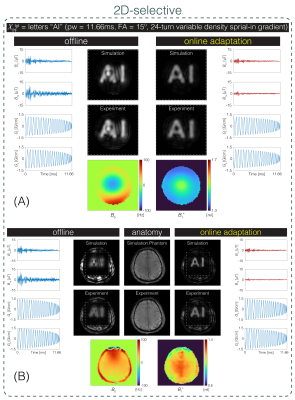 |
Computer Number: 145
4412. Generalize
RF Pulse Design using Physics-Guided Self-Supervised Deep
Learning
A. Jang, X. He, F. Liu
Athinoula A. Martinos Center for Biomedical Imaging, Charlestown, United States
Impact: GPS uses a case-specific strategy not requiring
diverse training data and enables a more general
RF-pulse-design approach. It can naturally be extended to
other designs such as SMS and pTx, and incorporate advanced
tissue models such as multi-pool systems.
|
|
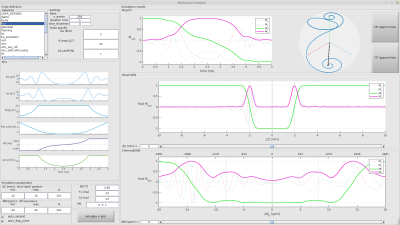 |
Computer Number: 146
4413. RF
pulse simulation in MALTAB: Interactive GUI and scripting
capabilities.
B. Béranger, J. Lamy, L. Mouton, M. Lapert
ICM, Paris, France
Impact:
While many open-source toolboxes can simulate radio-frequency (RF) pulses, this toolbox improves understanding and optimization of RF pulses, for both the sequence designer and for educational purpose. |
|
 |
Computer Number: 147
4414. Optimizing
Selective RF Pulses for Enhanced Signal Stability in Turbo Spin
Echo Using a Differentiable Extended Phase Graph Model

M. Albert, A. Sharma, M. Griswold, W. Grissom
Case Western Reserve University, Cleveland, United States
Impact: We present an RF pulse optimization method that
uses a differentiable EPG model to increase slice profile
consistency across TSE echoes. The optimized pulses reduced
blurring and ghosting in TSE images, with potential
applications to other echo train sequences.
|
|
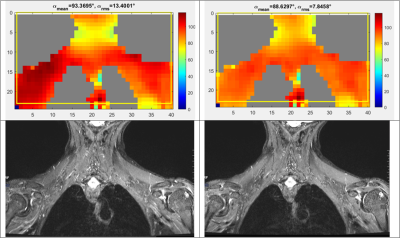 |
Computer Number: 148
4415. Mitigating
B1+ shading for 3D turbo-spin-echo imaging at 3T
N. Gross-Weege, J. Herrler, D. Grodzki
Siemens Healthineers AG, Erlangen, Germany
Impact: The work shows that sophisticated pulse design
can mitigate B1+ shading at 3T particularly in 3D
turbo-spin-echo imaging of the brachial plexus at the cost
of about 35% increased pulse energy and 40s increased scan
time due to additional preparations.
|
|
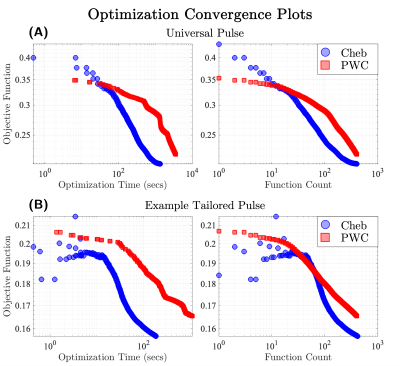 |
Computer Number: 149
4416. The
Ritz adjoint method for optimization of arbitrary waveform
excitation pulses: Demonstration in slice-selective parallel
transmission

J. Drago, G. Guryev, N. Arango, B. Guerin, L. Wald
Massachusetts Institute of Technology, Cambridge, United States
Impact: The Ritz adjoint method efficiently optimized
arbitrary waveform universal and tailored parallel
transmission slice-selective pulses that respect SAR
constraints and system limitations while correcting the flip
angle inhomogeneities for high-field excitations.
|
|
 |
Computer Number: 150
4417. 3D
High-Resolution Reduced Field-of-View T2-Weighted Imaging by
Combining 3D EPI and Spatially Selective Pulses

J. Yang, J-F Nielsen, J. Fessler, Y. Jiang
University of Michigan, Ann Arbor, United States
Impact: Our simulation and in vivo results demonstrated
the potential of obtained high-resolution T2-weighted images
in the brain and prostate. This shows the potential to
achieve high-resolution diffusion imaging using rFOV imaging
approach in the future study.
|
|
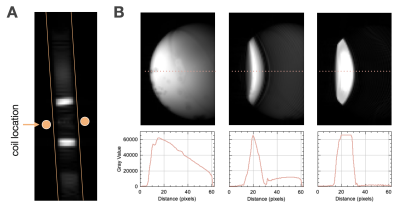 |
Computer Number: 151
4418. Adiabatic
B1-selective pulses
S. Kantesaria, D. Idiyatullin, E. Torres, M. Garwood
University of Minnesota, Minneapolis, United States
Impact: Slice selection without B0 gradients
allows for faster gradient switching, silent scans, and no
eddy currents. Low cost, portable MRI systems with no B0 gradients
can build off this pulse to recreate more mainstay sequences
of clinical MRI.
|
|
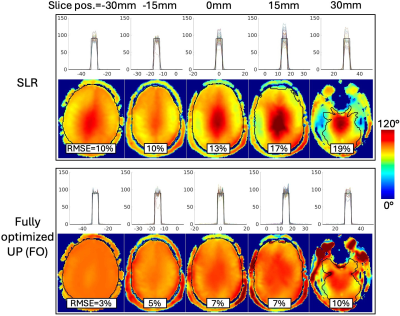 |
Computer Number: 152
4419. Slice-selective
universal pulses for brain imaging at 7 Tesla using a birdcage
coil
B. Guerin, J. Drago, J. Herrler, L. Wald, J. Stockmann
Massachusetts General Hospital, Charlestown, United States
Impact: Slice-selective fully optimized pulses solve the
FA brain homogenization problem at 7T using a birdcage coil
alone (no pTx) and yield box-slice slice profiles with
little phase variation inside the slice and little
excitation outside.
|
|
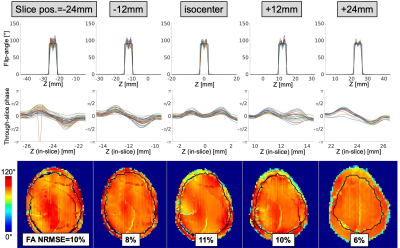 |
Computer Number: 153
4420. Slice-selective,
large flip-angle parallel transmission pulses for brain imaging
at 7 Tesla
B. Guerin, J. Drago, J. Herrler, L. Wald, J. Stockmann
Massachusetts General Hospital, Charlestown, United States
Impact: We propose fully optimized slice-selective 7T
brain pTx RF and gradient pulses with uniform flip-angle
distribution in-slice (~10% NRMSE), negligible out-of-slice
excitations and little in-slice phase variations.
|
|
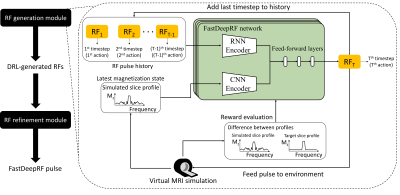 |
Computer Number: 154
4421. FastDeepRF:
Accelerated AI-Driven Radiofrequency Pulse Design through
Enhanced Reinforcement Learning and Distributed Computing
R. Datchanamourty, K. Min, J. Lee, M-h Oh
Seoul National University, Seoul, Korea, Republic of
Impact: FastDeepRF’s dramatic reduction in computation
time and increased efficiency open the way to broader
adoption of AI-designed RF pulses in clinical and industrial
settings, enhancing MRI exam outcomes through reduced SAR
and enhanced image quality.
|
|
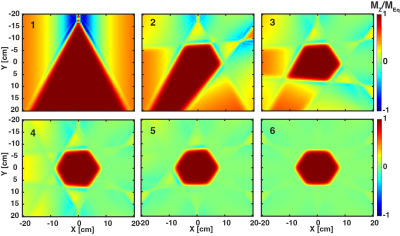 |
Computer Number: 155
4422. Gradient
swept adiabatic pulses for out of slice inversion and outer
volume suppression.
R. Ouwerkerk, N. Metwalli, A. Gharib
National Institute of Diabetes and Digestive and Kidney Diseases, Bethesda, United States
Impact: A new class of adiabatic inversion pulses with
frequency sweeps generated by gradient waveforms to yield
inversion outside a well-defined non-perturbed slice or
wedge delivers new options for pre-pulses for contrasts,
spatial selection, or outer volume suppression.
|
|
 |
Computer Number: 156
4423. Improved
signal linearity for channel-wise relative B1+ mapping at 7T
with an interleaved acquisition scheme
N. Egger, L. Ruck, S. Nagelstraßer, J. Schirmer, S.
Wildenberg, J. Herrler, A. Bitz, M. Uder, A. Nagel
Institute of Radiology, University Hospital Erlangen, Friedrich-Alexander-Universität Erlangen-Nürnberg (FAU), Erlangen, Germany
Impact: Compared to the conventional sequential scheme,
an interleaved acquisition of channel-wise relative B1+ maps
mitigates the risk of errors from exceeding the linear
regime, enhancing accuracy for applications susceptible to
this issue, such as body imaging at 7T.
|
|
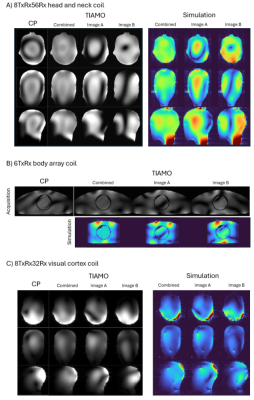 |
Computer Number: 157
4424. Optimising
TIAMO shim modes for non-conventional RF coils at 7T
B. Ding, C-Y Wu, D. Baskaran, A. Polpudenko, S. Chu, E.
McEwan, S. Williams, S. Allwood-Spiers, D. Porter, S.
Gunamony
Siemens Healthcare Ltd, Camberley, United Kingdom
Impact: This abstract will allow the application of
TIAMO on non-conventional RF coils (i.e. coils without a
fixed phase increment between adjacent transmit channels)
for 7T MR.
|
|
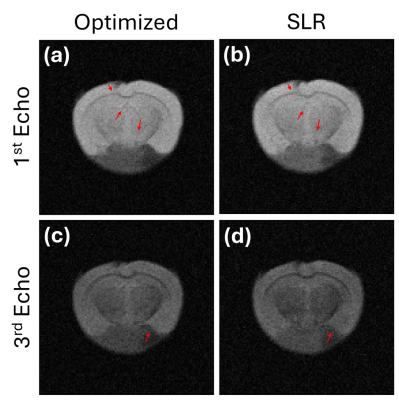 |
Computer Number: 158
4425. Optimizing
Radiofrequency Pulses using Deep Learning Frameworks
T. Parasram, J. Bondy, X. Dan
University of Windsor, Windsor, Canada
Impact: A neural network framework was developed to
create high-performance RF pulses that lead to improved
image quality. Constraints such as application-specific
considerations and hardware limitations or perturbations can
be easily incorporated into the framework for fast,
easy-to-use RF pulse generation.
|
|
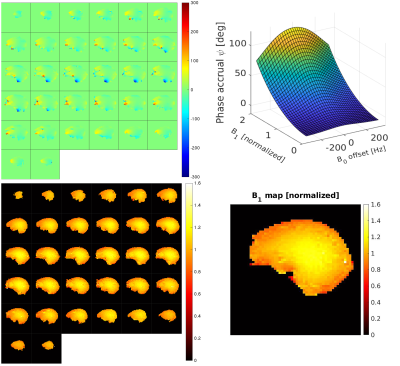 |
Computer Number: 159
4426. Rapid,
Low power PHIFA CUP B1+ Mapping
D. Santoro, F. Carinci, C. Aigner
Max Planck Institute for Human Development , Berlin, Germany
Impact: The proposed rapid, low-power B1+ mapping method
reduces acquisition time and SAR. This improvement enhances
its utility in clinical and research settings. Future work
aims to extend its application to 7T for pTx applications.
|
The International Society for Magnetic Resonance in Medicine is accredited by the Accreditation Council for Continuing Medical Education to provide continuing medical education for physicians.